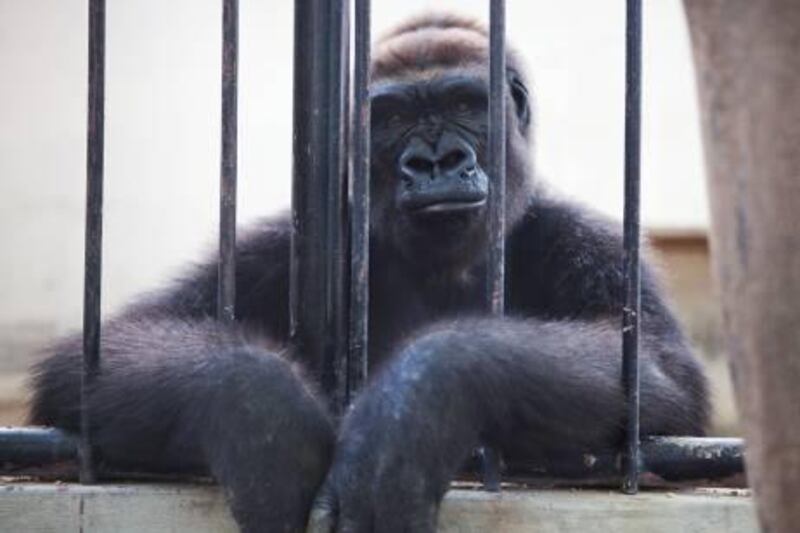DUBAI // Miles away from the climes where they should have made their homes, hundreds of birds, bears and cats appear to be struggling beneath the desert sun.
In Dubai Zoo, dozens of animals are crammed into small cages, share space with other species or have inadequate access to water.
The conditions in the government-owned zoo in Jumeirah have been a lightning rod for animal activists and online bloggers.
However, officials charged with running the park say that space is a problem but the animals are treated as humanely as possible.
On Monday, when temperatures reached 41°C, several animals were clearly struggling in the heat.
A brown bear paced in a central enclosure, its fur matted with sweat. The cage resembled a prison cell with a concrete floor and rusted jail bars.
The story was the same across the public zoo, which is thought to be about 20,000 square metres. In one pen, a gorilla sat in the centre of a dusty exhibit; in another, a lioness gulped hard with what looked to be dehydration; and in a small cage an Arabian fox walked in circles.
One visitor, a 31-year-old Indian shop worker who gave his name as Shiraj, said he was disturbed by the conditions.
"Some of the animals are doing OK but some of them are too hot," he said. "They look very sad."
All over the zoo animals appeared to be crowded into small enclosures. In one small cage, about 20 baboons fought for space. In another, as many as 30 flamingos huddled together next to a puddle of brown water.
The lack of space is evident throughout the zoo. Several ostriches in the collection are scattered throughout enclosures populated by other animals. One was placed with a herd of Barbary sheep, another with a large community of tortoises.
The pattern was repeated elsewhere - flamingos with a wallaby and a goldfish tank inside a lizard exhibit.
The zoo was almost deserted late morning on Monday. The majority of people were keepers charged with feeding the animals.
"There's nothing to be concerned about when it comes to feeding and taking care of these animals," said Ahmed Abdul Karim, the director of the Public Parks and Horticulture Department at Dubai Municipality, the authority that manages the zoo.
"That's up to international standards. The only issue is a lack of space. We have given a proposal to the concerned authorities about what's needed."
It would not be the first time officials have touted the idea of moving the animals to a new facility. The location has constantly been changing, from early plans in 2003 to relocate to Mushrif Park, to an ambitious scheme announced two years ago for a sprawling nature reserve in Dubailand.
Mr Abdul Karim declined to say what the new plans for expansion were or when they were likely to be ready.
The park opened in 1967 with several dozen animals. But that number has grown exponentially in recent years owing to the growth of animal smuggling and trade in exotic animals. A large number of the roughly 1,000 animals at the zoo are from private donations, or animals discovered by Dubai Customs.
Sometimes the zoo did not have the ability to accept the animals, said Dr Reza Khan, the former head of Dubai Zoo and a member of the International Union for Conservation of Nature (IUCN).
"The management of any small, city-centre zoo would have been clueless when it came to how to deal with the sudden influx of 800 baby parrots of a week old, or 18 macaque babies, or 200 baboon babies," he said.
"I was no exception and it was a nightmarish situation. It was a tremendous strain on our zoo employees and the management."
He said that on one occasion zoo staff had just 10 hours to find a place outside of the zoo that could house 2,000 sandgrouse, sent as a gift to a Dubai family.
He said that on another occasion two large wild cats - an African Civet and an African Serval - were donated to the zoo after the owners had found that they weren't the domestic tabbies they thought they had purchased.
"I told them they weren't even close to what they thought they'd purchased," said Dr Khan.
Last year, the zoo was targeted by activists from the People for the Ethical Treatment of Animals (Peta) when several protesters dressed in monkey outfits and carried signs reading: "Zoos: cruel animal prisons
One of those who participated, the Hong Kong-based activist Ashley Fruno, said that the standards at Dubai Zoo are "beyond decrepit".
"On top of the barren, cramped cages, the animals are forced to deal with the sweltering heat," she said.
Peta takes a stand against keeping animals in captivity, but Ms Fruno said that some zoos do provide better conditions for animals than others.
"There can never truly be a good zoo, but there can be some which are better than others," she said.
"Dubai Zoo is certainly not one of those."






